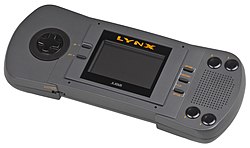| Awesome Golf | |
|---|---|
 Cover art in all regions | |
| Developer(s) | Hand Made Software |
| Publisher(s) | Atari Corporation |
| Producer(s) | Juliana Wade |
| Designer(s) | Jim Gregory |
| Programmer(s) | Chris Manniex Rob Nicholson |
| Artist(s) | Val Gregory |
| Composer(s) | Paul Tonge Tony Williams |
| Platform(s) | Atari Lynx |
| Release | |
| Genre(s) | Sports |
| Mode(s) | Single-player, multiplayer |
Awesome Golf is a 1991 golf video game developed by Hand Made Software and published by Atari Corporation in North America and Europe exclusively for the Atari Lynx. [1] [2] The first project to be created by Hand Made Software, players have the choice to compete either solo or against other human players using the console's ComLynx system on matches set in any of the three available countries across any of the game modes available. Its gameplay mainly uses a two-button configuration.
Contents
Awesome Golf was developed by most of the same staff that would later go on to work on future projects for Atari Corp. such as Kasumi Ninja on the Atari Jaguar. Atari had plans to develop a golf title for their Lynx platform and Hand Made Software travelled to meet with the company in order to work on a title for a handheld game console, which Atari agreed and decided to trust their golf project to the latter after being impressed with the team's abilities.
Awesome Golf was met with positive critical reception from video game magazines and dedicated outlets that reviewed the game since its launch, with reviewers praising several aspects such as the presentation, visuals, digitized voice samples, controls and gameplay, though some criticized other aspects of the title like the sound design. After its release, Hand Made Software would go on to develop five more titles for the Lynx. [2]

